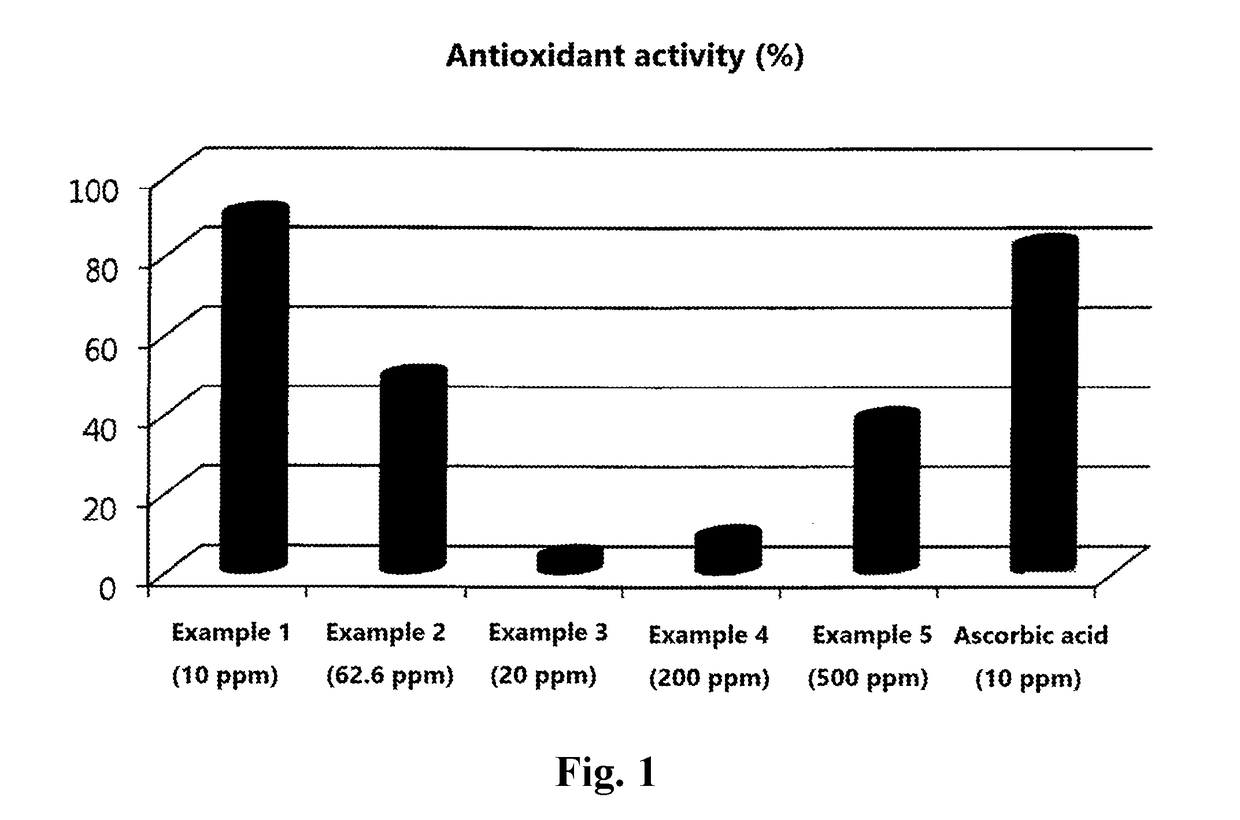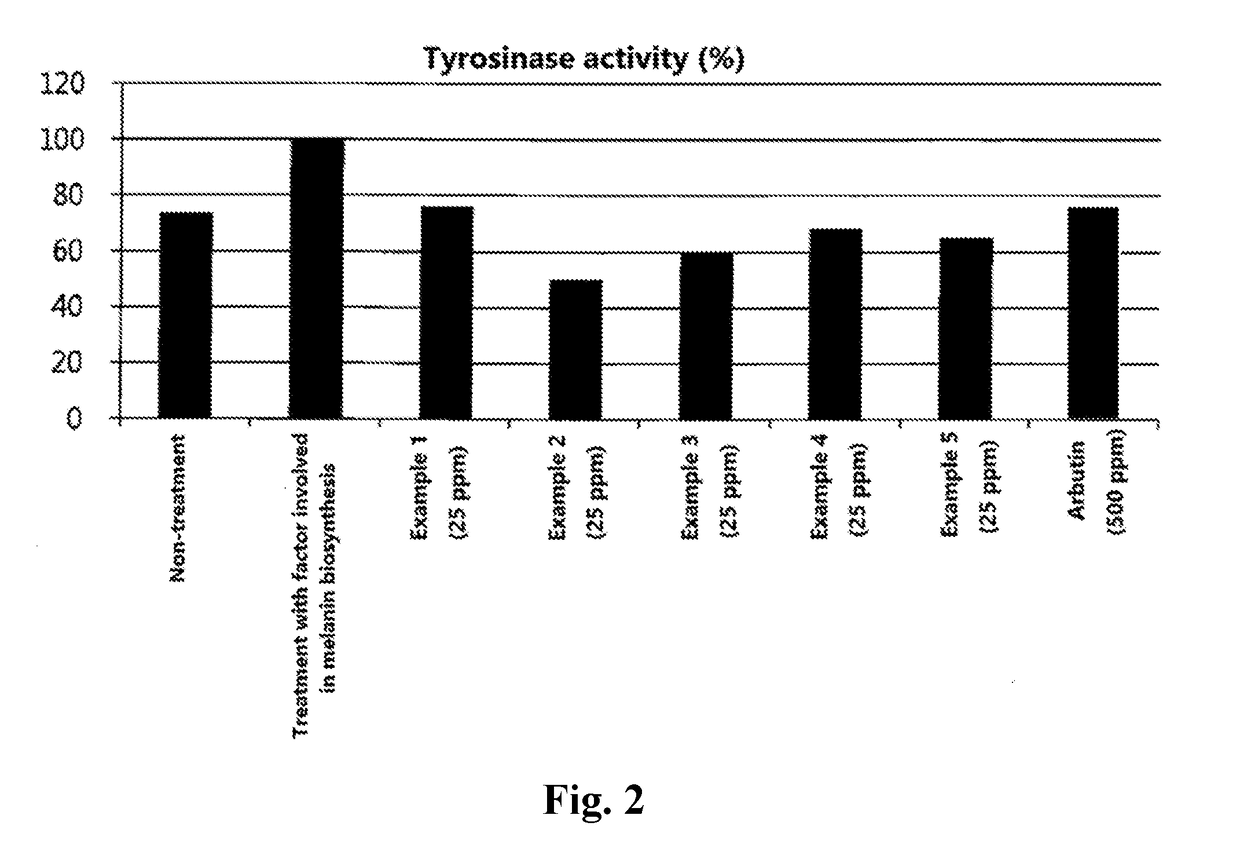Novel phenolic acid derivative compound and use thereof
a technology of phenolic acid and derivative compounds, applied in the direction of dermatological disorders, drug compositions, anti-noxious agents, etc., can solve the problems of limited use, excessive production of melanin, and severe aesthetic problems
- Summary
- Abstract
- Description
- Claims
- Application Information
AI Technical Summary
Benefits of technology
Problems solved by technology
Method used
Image
Examples
example 1
Preparation of (S)-ethyl-3-phenyl-2-(3,4,5-trihydroxybenzamido)propanoate
[0049]
(1) Preparation of (S)-ethyl-3-phenyl-2-(3,4,5-triacetoxybenzamido)propanoate
[0050]In a 100 mL flask, 3,4,5-triacetoxybenzoic acid (3.55 g), dichloromethane (12 mL) and DMF (0.1 mL) were added and was stirred at 5° C. To the mixture was added dropwise oxalyl chloride (1.7 mL). After stirring the resulting mixture for 6 h at room temperature, the reaction solution was concentrated fully under reduced pressure to afford 3,4,5-triacetoxybenzoyl chloride.
[0051](S)-phenylalanine ethyl ester hydrochloride (2.75 g), dichloromethane (12 mL), and diisopropylethylamine (6.2 mL) were stirred in a 100 mL flask at 5° C. and a solution of the 3,4,5-triacetoxybenzoyl chloride in dichloromethane (10 mL) was added dropwise. After stirring the mixture for 3 h at room temperature, the reaction mixture was concentrated at reduced pressure. The resulting solid was dissolved in ethyl acetate (50 mL) and washed with water, a sa...
example 2
Preparation of (R)-ethyl-2-amino-3-(4-hydroxy-3,5-dimethoxybenzoylthio)propanoate
[0054]
(1) Preparation of (R)-ethyl-2-amino-3-(4-acetoxy-3,5-dimethoxybenzoylthio)propanoate
[0055]In a 100 mL flask, 4-acetoxy-3,5-dimethoxybenzoic acid (4.8 g), dichloromethane (20 mL) and DMF (0.1 mL) were added and the mixture was stirred at 5° C. To the mixture was added dropwise oxalyl chloride (2.4 mL). After stirring the resulting mixture for 6 h at room temperature, the reaction solution was concentrated fully under reduced pressure to afford 3,4,5-triacetoxybenzoyl chloride.
[0056](R)—N-acetylcysteine ethyl ester (3.6 g), dichloromethane (20 mL), and diisopropylethylamine (10 mL) were stirred in a 100 mL flask at 5° C. and a solution of the 4-acetoxy-3,5-dimethoxybenzoyl chloride in dichloromethane (20 mL) was added dropwise thereto. After stirring the mixture for 3 h at room temperature, the reaction solution was concentrated at reduced pressure. The resulting solid was dissolved in ethyl acetat...
example 3
Preparation of (R)-methyl-2-acetoamido-3-(4-hydroxy-3,5-dimethoxybenzoylthio)propanoate
[0059]
(1) Preparation of (R)-methyl-2-acetoamido-3-(4-acetoxy-3,5-dimethoxybenzoylthio)propanoate
[0060]In a 100 mL flask, 4-Acetoxy-3,5-dimethoxybenzoic acid (3.6 g), dichloromethane (15 mL) and DMF (0.1 mL) were added and the mixture was stirred at 5° C. To the mixture was added dropwise oxalyl chloride (1.6 mL). After stirring the resulting mixture for 6 h at room temperature, the reaction solution was concentrated fully under reduced pressure to afford 4-acetoxy-3,5-dimethoxybenzoyl chloride.
[0061](R)—N-acetylcysteine methyl ester (2.7 g), dichloromethane (15 mL), and diisopropylethylamine (4 mL) were stirred in a 100 mL flask at 5° C. and a solution of the 4-acetoxy-3,5-dimethoxybenzoyl chloride in dichloromethane (15 mL) was added dropwise thereto. After stirring the mixture for 3 h at room temperature, the reaction solution was concentrated at reduced pressure. The resulting solid was dissol...
PUM
| Property | Measurement | Unit |
|---|---|---|
| concentration | aaaaa | aaaaa |
| concentration | aaaaa | aaaaa |
| weight | aaaaa | aaaaa |
Abstract
Description
Claims
Application Information
 Login to View More
Login to View More - R&D
- Intellectual Property
- Life Sciences
- Materials
- Tech Scout
- Unparalleled Data Quality
- Higher Quality Content
- 60% Fewer Hallucinations
Browse by: Latest US Patents, China's latest patents, Technical Efficacy Thesaurus, Application Domain, Technology Topic, Popular Technical Reports.
© 2025 PatSnap. All rights reserved.Legal|Privacy policy|Modern Slavery Act Transparency Statement|Sitemap|About US| Contact US: help@patsnap.com



